Updated: 08-Sep-2020
MOTORES ESPECIALES Y RAROS (SPECIAL AND STRANGE ENGINES)
(International)
We continue to discover unorthodox engines, some of them variants of the rotary piston ones, after having admitted as “normal” the alternative piston and the turbine engines. Let's start with a new batch located in Popsci.
-The Mercer is due to its inventor Austin Mercer from USA. In its first simplified versions it had only two opposed pistons within a cylindrical body. Each piston has rollers that follow an 8-shaped hole.
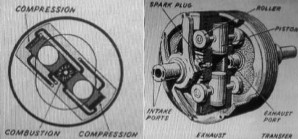
"Schematic and drawing of the Mercer with two pistons"
-Subsequently he presented the four-cylinder version, running on the two-stroke cycle.
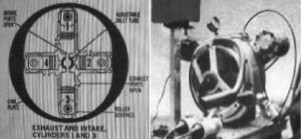
“Schematic drawing and photograph of the four-piston engine”
-In this diagram, we can better see the inner eight-shaped body through which the rollers slide, which in this case are at the opposite ends of the piston head.
-The combustion chambers are towards the center of the engine and a shaft with holes open and close the ports to produce the cycles.
-Better than in photography we have the magnificent work of a draftsman from said magazine in which many more details can be seen.
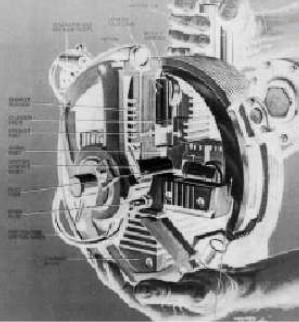
"Outstanding Mercer Engine Drawing"
-Another bizarre engine is the one of Frenchman André Brulfert of Marseille.
-The experimental model was a two-cylinder, air-cooled engine with a displacement of 175 cc. It was also called "Turbomotor".

"André in front of his engine"
-The engine has double-acting pistons with a joint in the middle. They are mechanically linked.

“Schematic drawing of Brulfert's engine”
-It has a pump which sends oil through turbines and non-return valves to the piston bases to carry out the compression cycle.

"The drawing shows the internal mechanism"
-Another strange engine is the Try-Dyne. It is an engine with a more or less triangular rotary piston whose vertices fit into valves that rotate located at 180° within the piston space.
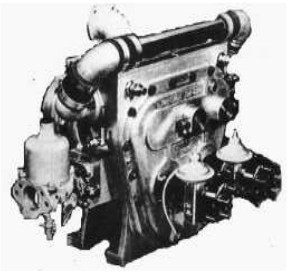
"Photo of a Try-Dyne"
-Schematically it can be represented as follows:
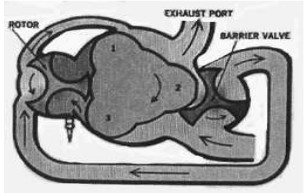
“Schematic diagram, modified for didactic purposes”

“More realistic piston appearance”
-The Anidyne opposed four-cylinder engine has two double pistons in one piece with eccentrics in its center hole.
-The “crankshaft” is a shaft with a central cam for one of these double pistons and two semi-cams on each side of this central cam for the other double piston. We see it like this.

"Detail of the pistons and central shaft with cams"
-And a good Popsci drawing with the complete engine.

“The Anidyne”
-The Rajakaruna engine of which, as we see, there is a practical model that is difficult to concept and understand, but here it is.

"The Rajakaruna engine"
-The unusual thing is the piston system that beats like a heart, thanks to its articulated walls.
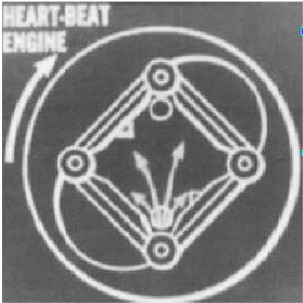
“In the Rajakaruna engine the outer body rotates”
-In a summary of Popsci (see) several types of rotary engines appear, studied but not put into practice.
-One of them is the Sima, based on the design of the old Ranelli pump.
-Together with the schematic of the previous engine, the Isuzu engine is shown, tested with its truncated rotor inside a trilobed cylinder.

"The Sima and the Isuzu"
-Another rare concept is that of Geiger rotating in an oval cylinder, the pistons being shoes attached to a triangle.
-The other engine of the same figure is Franke's. Both engines are projects from the early 1960's.
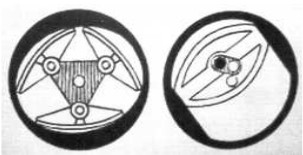
"The Geiger and the Franke"
-The Virmel engine has two opposed double pistons.

“Virmel engine details”
-It has many similarities with the below Kauertz and also others that appear in this publication.
-In the Kauertz the movement of the vane pistons is assisted by articulated connecting rods. We see two versions.
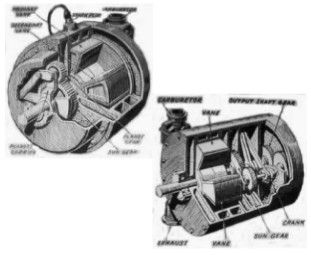
“Two Kauertz versions”
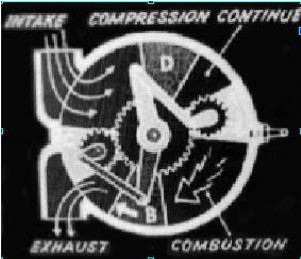
“Kauertz engine schematics” (PiP)
-The same mechanisms -or very similar- are used in the Tschudi engine but with toroidal cylinders and curved pistons.

“Tschudi engine drawing” (PiP)
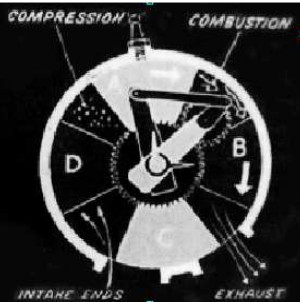
“And the scheme of its operation” (PiP)
-Wallace Linn's engine of which we only have its outer form, not possessing more information. We will continue to investigate.
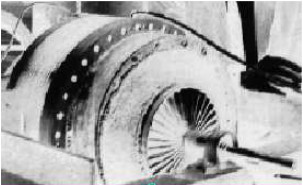
“Wallace next to his engine” (PiP)
-From other publications (than Popsci) we provide more rare engines, as a curiosity.
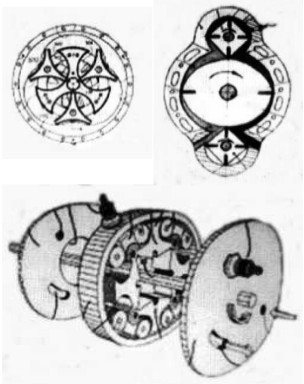
“Three rotary motors according to their patents”

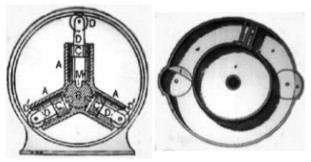
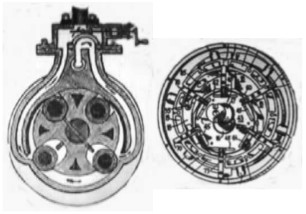
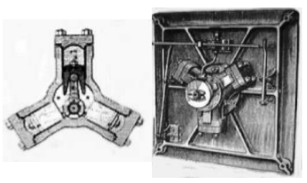
-Diving in patents you can see great ideas. We have a latest three-cylinder design and its practical realization.
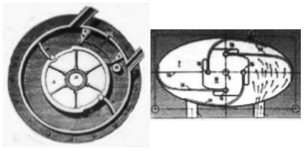

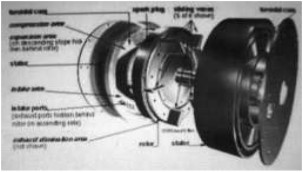
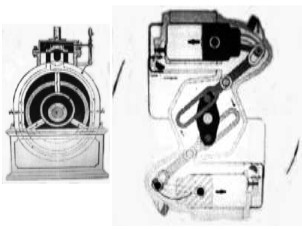
-The last engine on this page is the "Rotoruiz" completely rotating and with a complex connecting-rod system.
-Precisely this engine is mentioned in another chapter of this publication.
-In the patent offices of industrial countries there are often inventions of air propulsion systems.
-We show a few below.
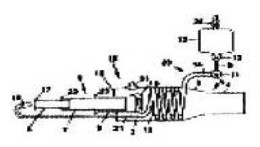
"Pulsejet"
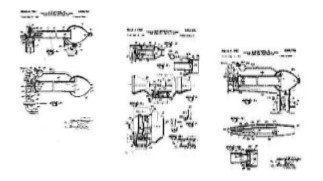
“Various examples from US Patent. Office”

“Gough Engine”
-For example, the Gough was patent 1,737,082. It is not known if it has been built, perhaps due to its complexity and unpromising result.
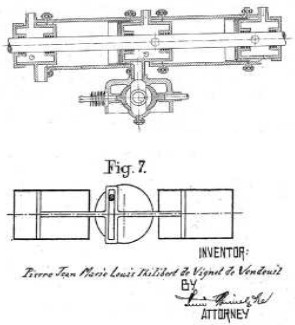
“Vignet and Vendeuail patents”
-In a way it is a variant of other engines without the classic oscillating connecting rods, for example the Bourke.

"Brogdon Engine"
-Although it seems of common construction, it is made up of two half-crank-cases with cylinders included. It seems to be Diesel. (Pressure-Combustion as it was sometimes said).
-And now, a surprise for the author of this publication "Aerospace Engines, A to Z".
-Reviewing the bibliography of American "Mechanix Illustrated", on January 31, 2010 is an article on -Model Jet Engines- or small jet engines.
-They organized an open contest among its readers in 1945.
-The prize was $ 350 at the time. And only the project or photographs had to be sent.
-To evaluate it, it was not prescribed to send the models and the assessment was made by the magazine's specialized editors themselves.
-Below we show the conditions of the contest and five of the presented models.


"Posted in Mechanix Illustrated"
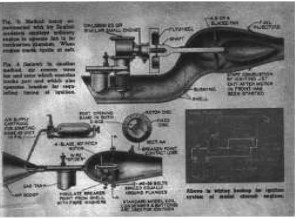
“Presented models”
-The system in Figure 3 is that of the "Jet Engine". Like the Caproni-Campini engine, a piston engine drives the compressor, and the rest is equal to a turbojet.
-Years later and without any connection to this award, the author of this publication, Ricardo Miguel Vidal, did an incredibly similar test with his Byra 2.5 cc engine. (See Micromotors). This was in 1959 and was explained in the "Flaps" magazine number 65, in Valladolid.
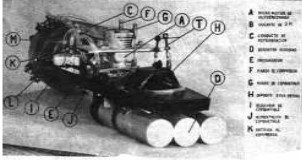
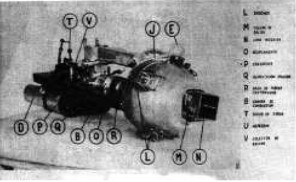
"Photos 1 and 2 of the RMV engine"

“RMV engine schematics”
-In case there is difficulty in reading the references described, they are repeated below:
-A. Micro self-ignition motor.
-B. Starter flywheel.
-C. Cooling duct.
-D. Kerosene tanks.
-E. Pressurization.
-F. Compression knob.
-G. Fuel control.
-H. Ether-petroleum-castor oil tank.
-I. Fuel regulator.
-J. Fuel supply.
-K Inlet to compressor.
-L. Brooches.
-M. Outlet nozzle.
-N. Inner cone.
-O. Coupling.
-P. Carburetor.
-Q. Cross feeding.
-R. Centrifugal mass box.
-S. Combustion chamber.
-T. Loading mouths.
-U. Sprinkler.
-V. Diesel exhaust manifold.
-In the cross-section diagram it can be seen that the combustion chamber is very similar to those of Turbomeca. Even the fuel enters by spraying, spraying through the perforated drum (U).
-To facilitate construction, the jet engine nozzle has a square section. (M).
-The fuel is in three interconnected and pressurized tanks.
-Another extravagant engine is one that takes advantage of the combustion momentum of a valve engine (principle used by the Lorin engine) and create a reaction that takes the machine forward.
-We provide the extract of a page of this type of engine.
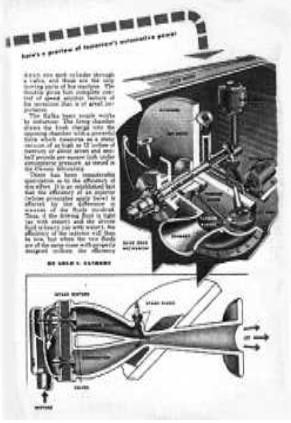
"Article in a technical magazine"
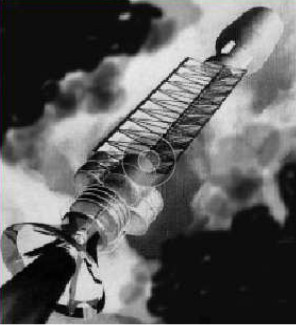
“Possible vehicle powered by these engines” (PiP)
-An experimental idea is the "Matter-antimatter" engine.
-When matter comes into contact with antimatter they mutually eliminate each other, giving a higher energy of great density than any other known reaction medium.
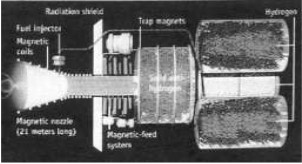
“Schematics of an anti-matter engine” (PiP)
-If hydrogen and anti-hydrogen are introduced into the engine, they would come into contact in a chamber, and this formidable force would be generated, which would be directed towards the magnetic nozzle to produce thrust.
-From the Citroënet website, an assortment of engines with unusual operating principles. And they are very old, because at the beginning, already in 1799, a certain Murdock presented a steam engine with the principle of a rotary pump operating in reverse.
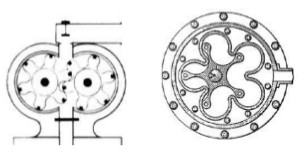
"The Murdock and the Galloway"
In 1846 Elijah Galloway presented his rotary engine with an inner epicycloid. In 1901 Cooley presented his eccentric epicycloid engine. And in 1908 Umpleby made a variant of the Cooley.

“The Cooleys and Umpleby engines”
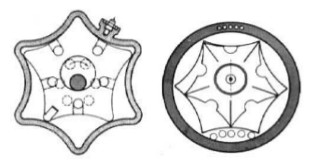
“The Wallinder-S and the Sensaud et Lavaud engines”
-The year 1923 is that of the Swedes Wallinder/Skoog and 1938 that of the French Sensaud et Lavaud. Both with the principle of one of the piston-engine lubrication pumps.

“The Maillard”
-Based on an English patent, the Swedish manufacturer Maillard first made a compressor with the idea of letting it run as an engine.
-Clearly an antecedent of the Wankel since it is the year 1943.
-A triangle rotating within a hypocycloid chamber.

"A rare and complicated Rotoruiz"
-The unit has two cylinders with two rocker arms that have a slotted hole at the end that goes on the crankpin of the crankshaft. See above.
-Of the current rare engines that are being investigated, we can consider others, such as the Wolfhart, invented in Germany in the 1970s by Wolfhart Willimezik.
-The piston is spherical and has an oscillatory movement, with a two-stroke cycle. We see something similar with the Nutating Engine, later.

“Wolfhart engine”
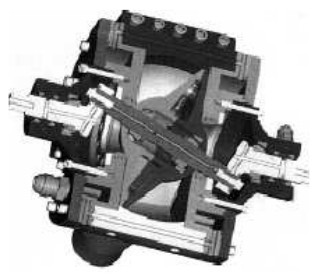
“Split sphere that performs an oscillating movement”
-The Nutating Engine that is planned for UAVs, is basically an inclined oscillating disk on a sphere.
-In its rotation it creates compression and explosion chambers, reaching compression ratios of 10: 1.
-What catches our attention is the large number of radial seals arranged on the side walls. Although the crankshaft is straight, the crankpins are sloped.
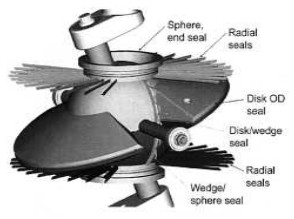
“Nutating schematic drawing with complex seals"
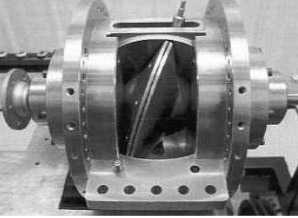
“Cutaway of a real Nutating engine"
-There are one and two body designs. Here are a series of designs conceived for use in UAVs. (Unmanned Aerial Vehicle).
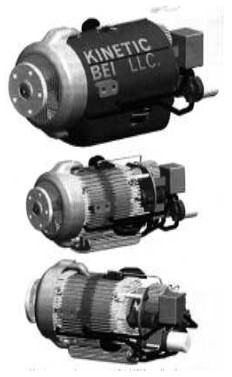
“Various Nutating engines for UAV”
-The invention of Roberto Callegaro from Italy may have an inspiration in the Wankel, but the piston is clearly different.

"RC-2000 motor designed by R. Callegaro"
-Another engine is that of Eliodoro Pomar, presented around 2005. It is said to be one-stroke and with four “ejections” each turn, giving four times the effectiveness of the two-stroke engine and eight times more than the four-stroke engine. We still do not have any illustration of this engine.
-Radial motor with four peripheral cylinders placed tangentially.
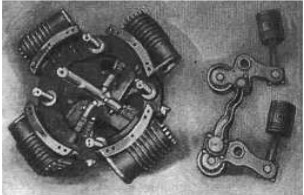
"Detail of the block and cylinders"
-We also see the pivoting articulated pistons and connecting rods. On the head of the connecting rods there are rollers that will slide on the power shaft with double cam. Every two articulated units are joined by a tortuous linkage to keep the rollers in continuous contact.
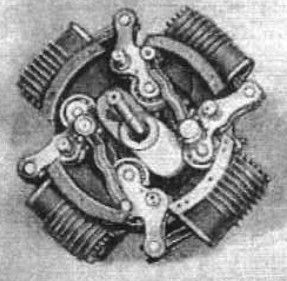
"Appearance of mounted pistons"
-It is easier to understand in this illustration of the combined engine's interior.
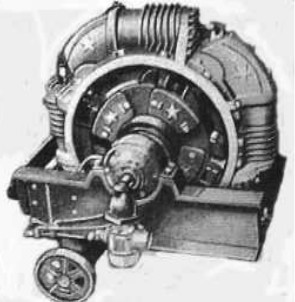
“The completely assembled engine”
-The whole engine looks interesting. We see the carburetor in the front line. As for its use in aviation, it is not mentioned. But it seems to be in the line of the Fairchild Caminez.
-Darracq used a type of rotary valve, interesting although for a 2-stroke cycle. It was tested in the automotive industry and it is not known if it is done in aviation. This was in the beginnings of the 1920’s.
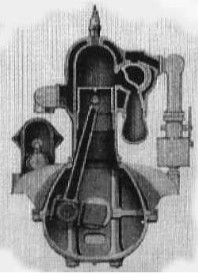
“Darracq engine with rotary valves”
-The valve looks cylindrical in shape, but since there is nothing new under the sun, modern engines with rotary but spherical valves have recently appeared.
-Below there is an assortment of 3 special mechanisms:
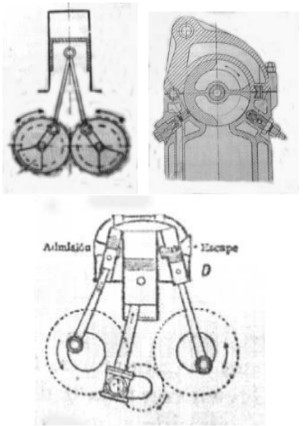
"Connected crankshafts, rotary valves and piston"

"An old magnetic motor (?)"
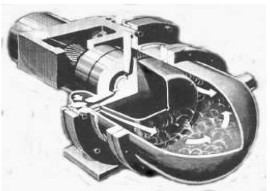
"Chemical steam turbine"

"Driven by laser (theoretical)"

“And a mixed motor for subsonic speeds (top)
and supersonic: Turbojet and Ram-Jet ”
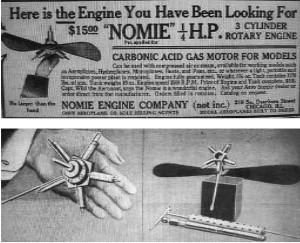
"Compressed air-Co2 micromotors"
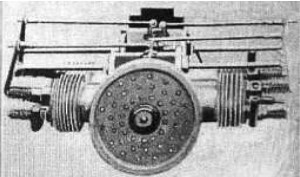
“6x4x2-inch gasoline micromotor”

"Reduced-scale engine model"
-The evolution of micromotors has run parallel to that of larger engines. For example, miniature radials are not a thing of recent times, as early as the 1920's/30's these wonders of mechanics were being made.
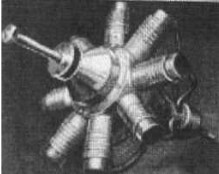
"With a rudimentary look"

"Looking like a Bristol Jupiter"
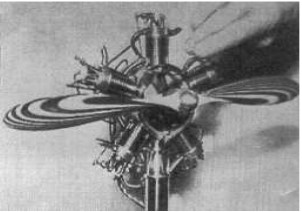
"A really beautiful set"
-Small Co2 engine made with a homemade lathe. Perhaps the smallest reciprocating engine the author has seen.
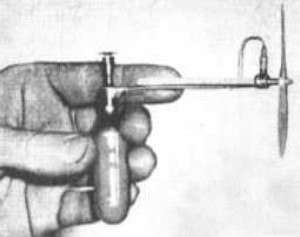
"Co2 micromotor in one hand for comparison"
-Below we show a rare model aircraft engine with an axial piston and the upper shaft with a propeller groove.

"The original engine in the hands of its inventor"


